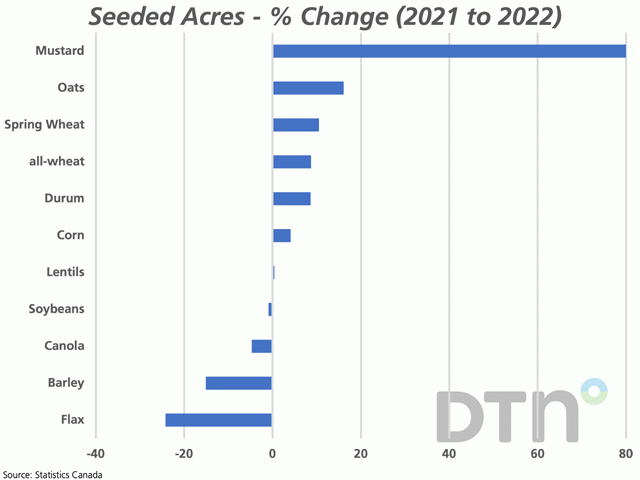Canada Markets
Statistics Canada Revises Acreage Estimates
Statistics Canada revised their seeded acre estimates in Principal Field Crop Areas, June 2022 report. A reported 25,000 producers were surveyed over the May 13 through June 12 period. This report also included surveys conducted within smaller producing provinces, which Statistics Canada reports make up 2% to 4% of the total acreage. The June 12 cut-off in the survey would fail to capture all prairie activity with seeding in some areas extending past this date, while it is highly likely that many surveys were conducted in May and early June with producers facing varying weather conditions and planting prospects.
When all of the crop areas are added, seeded area of 77.5775 million acres (ma) are 335,500 acres or .4% below 2021 while 59,540 acres or less than .1% higher than the five-year average, despite the excessive precipitation that hit the eastern Prairies this spring. Summerfallow acres, estimated at 1.8087 ma, are reported 472,200 acres or 35.3% higher than 2021, while the highest area estimated in five years.
Canada's all-wheat acres are estimated at 25.395 ma, up 8.7% from last year, while the largest area seeded in nine years. This area was revised 364,000 acres higher from the previous report based on March estimates.
The area seeded to durum was revised 218,100 acres lower from the March estimates, but at 6.006 ma, is up 8.6% from 2021 and is the largest durum area seeded in four years. The June AAFC forecast shows durum stocks jumping from 550,000 metric ton (mt) to 1 million metric tons (mmt) in 2022-23 based on average yields, while a slightly smaller area estimated this month would result in less of a jump.
P[L1] D[0x0] M[300x250] OOP[F] ADUNIT[] T[]
Spring wheat acres were estimated at 18.212 ma based on June surveys, up 578,000 acres from the March estimate and up 10.5% from 2021 at 18.212 ma. This would be the largest spring wheat area seeded in three years and is 5.5% higher than the five-year average. AAFC's June forecast shows a rise in forecast stocks of 1 mmt from 2021-22 to 2022-23 for wheat except durum, while Tuesday's upward revision in acres will result in an even larger increase in stocks without an increase in demand.
Canola acres were estimated at 21.416 ma, which includes an upward revision of 519,500 acres from the March estimate, while is down 4.7% from 2021 and 2.9% below the five-year average. While supportive for canola overall, Tuesday's reports failed to lead to buying interest, with canola caught in a global sell-off of commodities and outside markets. AAFC's June forecast included a modest increase in stocks from 2021-22 to 2022-23, while a slightly higher area seeded may add further to this increase without higher demand.
Canola acres fell across all three Prairie provinces from 2021 to 2022, with a 6% drop recorded for Saskatchewan, 4.3% drop in Manitoba and 3% drop in Alberta.
Soybean acres were estimated at 5.274 ma, down 83,500 acres from the March estimate while down a modest .9% from 2021. While both Saskatchewan and Manitoba pared acres seeded, both Quebec (3.3%) and Ontario (4.9%) increased acres, with the year-over-year increase in brackets. It is interesting to note that late planting across the eastern Prairies led to reduced acres planted; while Statistics Canada reported Manitoba's seeded acres down 170,800 acres from the March estimate, the June 21 Manitoba Crop Report indicated soybean acres planted were down 300,000 to 400,000 acres from the intended acres. Soybean stocks will remain extremely tight over the 2022-23 crop year.
Corn acres were estimated at 3.633 ma, which included an 81,700-acre lower revision from the March estimate. This area is up 4.1% from 2021 and 1.2% higher than the five-year average. This includes a 2.9% increase in Manitoba acres, a .7% increase in Quebec and a significant increase of 6% in Ontario where 62.6% of the country's acres are forecast to be seeded in 2022.
Of the larger crops, the largest percentage gain from 2022 to 2023 is seen with a 16.1% increase in oats to 3.972 ma, although this included a modest 19,700 acre drop from the March intentions report. This would be the largest oat area seeded since 2008 or in 14 years, while also 16.1% higher than the five-year average.
Tuesday's estimate included a 446,200-acre drop in the estimate for barley acres from the March intentions report, while the forecast area of 7.045 ma is down 15.1% from 2021, .8% below the five-year average and the lowest area seen in four years. Based on AAFC's forecast for 2022-23, calculated using average yields and a historic low carry-in, supplies will rise by 1.377 mmt in 2022-23, exports will rise in the year ahead and the feed industry will be forced to continue to rely heavily on U.S. imports of corn.
Canada's statistics agency reduced its forecast for dry pea acres from their March intentions estimate by 451,400 acres to 3.368 ma, down 11.8% from 2021, down 16.3% from the five-year average and the smallest area seeded in nine years. Statistics Canada also reduced their estimate for lentil acres since their first estimates were released to 4.320 ma, up .4% from one year ago and would be the largest area seeded in five years.
Cliff Jamieson can be reached at cliff.jamieson@dtn.com
Follow him on Twitter @Cliff Jamieson
(c) Copyright 2022 DTN, LLC. All rights reserved.






Comments
To comment, please Log In or Join our Community .